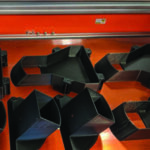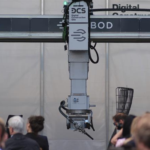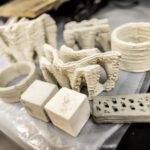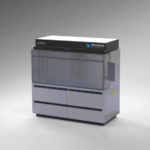It’s easy to think that modern supply chains are as efficient as they’ve ever been considering how the resources of so many countries and companies can be leveraged through instant telecommunications to find every possible solution to any given problem. Global supply chains are certainly more complex than they’ve ever been. Complexity is not an absolute good, though. It comes with tradeoffs.
In many ways, it’s true that today’s supply chains are very efficient, depending on the definition of efficient used. If a manufacturer has several vendors of a specific component, it has some flexibility if their preferred vendor suddenly can’t provide that component. But sometimes supply chains can become so large and complex that manufacturers can’t fully track the origins of source materials. If all the vendors of that same component are sourcing raw materials from the same supplier and that supplier shuts down for any reason, then all manufacturing of that component comes to a screeching halt because of a single kink in the supply chain. That’s the situation many manufacturers, especially those that make medical devices, currently find themselves navigating in the midst of the COVID-19 pandemic.
It isn’t uncommon to have four or more tiers of suppliers; this complex “fan out” means it’s extremely difficult for companies to have visibility into who all their suppliers actually are. This is one of the reasons we continue to have surprises when a major disruption occurs. Willy Shih, Professor of Management Practice in Business Administration, Harvard Business School
The Complexity of Modern Supply Chains
We’ve extensively covered the fervent response of the 3D printing community to help battle COVID-19 but let’s take a closer look at the state of supply chains and then examine how AM can decrease their sensitivity to disruptions. A combination of technological, economic, and sociopolitical changes that have occurred over the last couple of decades has greatly expanded the breadth of supply chains and manufacturing. The internet instantly connects consumers and sellers, global shipping routes move rare and regionally-sourced materials to all corners of the globe, and advanced analytics allow suppliers to predict demand and adjust inventories accordingly.
At first glance, it seems manufacturers have more options than ever had to avoid disruptions, but growing differences in the cost of labor between countries paired with international trade deals have led to many western countries (where labor costs more) outsourcing their manufacturing and assembly to eastern countries (where labor costs less). That means a large chunk of small consumer goods are being manufactured very far away from the end user and that translates to significant time and logistical costs to deliver those goods. Most people would not define that as an efficient system, but if you’re measuring efficiency by the total cost of manufacturing plus shipping, then having China make our smartphones is the most efficient choice because even with the extra shipping fees it’s still cheaper than making them in western countries.
Impactful Events
That is until factories and plants in China shut down because of a spreadable disease. Or freight companies stop shipping containers from leaving the country for the same reason. This pandemic may seem like a freak occurrence but there are a number of events that can cause serious disruptions to seemingly-sturdy supply chains. According to a 2018 survey by Supply Chain Insights LLC, the top three events to impact supply chains from 2013 to 2018 were cyber attacks, a West Coast port slowdown, and Hurricane Harvey. That’s a technological cause, an economic one, and a natural event. As supply chains grow to be larger and more complex, there become more events that can lead to problems. Other impactful events include:
- – Changes in trade policies
- – Wars
- – Government shutdowns
- – Shipping accidents and piracy
- – Currency fluctuations
- – Other natural events like earthquakes, drought, wildfires, flooding, and blizzards
Another growing trend that increases sensitivity to disruptions is “just-in-time” manufacturing, where inventories are precisely matched to predicted demand through employing those advanced analytics mentioned earlier. It saves suppliers cash when everything is running smoothly but causes real headaches when things don’t go to plan. A sudden uptick in demand is difficult to meet with traditional manufacturing when the supply chain is both vast and lean. It’s not as simple as asking another manufacturer to step in and fill the unmet demand because injection and cast molds take a lot of time to fabricate, ship, install, and train operators on their use. Plus, they’re incredibly expensive. Often, getting beyond the ‘breakeven’ point to profitability is only feasible if the molds are made once for a single manufacturer. Making a whole new set of molds could put a supplier back into the red for several years to accommodate the increased production, assuming that increased demand even holds. If it doesn’t, the supplier loses money on those molds. That’s one of the many risks that suppliers and manufacturers have to consider when dealing with supply chain disruptions.
In 2016, the US Department of Commerce released a report that detailed vulnerabilities in the global supply chains of aerospace titanium. Nearly all titanium products came from supply chains that originated in China, Russia, and Japan, and almost a quarter of the products were categorized as “sole source,” as in there’s no equivalent supplier available. While it takes 15-16 weeks to ramp up manufacturing for machining and forging, the two most common methods of manufacturing titanium components, suppliers were stocking only 5-16 weeks of product inventory. That’s a great example of a supply chain that’s sensitive to unforeseen disruptions.
How 3D Printing Can Help
As clunky and slow as conventional manufacturing is, that’s how light and nimble 3D printing is. To produce a component that has a number of different parts with injection molding, a factory has to be tooled up with the specific jigs and molds to make each part, and the factory is locked in that configuration until production is over. But a single 3D printer could produce each of those parts and still be able to make other parts in between with zero tooling changes. If more than a few units are needed, it’s as simple as adding more printers because they don’t become obsolete after that specific production run; they can easily transition to the next product. Because of the digital inventory that comes with 3D printing, it’s drastically more capable of working around disruptions. Let’s say a plant running a fleet of 3D printers loses power, a common occurrence in the world of manufacturing. Their production managers could just contact a nearby 3D printing service, send them the digital design files over the internet, and have production resumed in a matter of hours. That’s impossible with all other forms of manufacturing. Here are some other ways AM can make supply chains more resilient:
- – Locally manufactured – Making goods closer to the end user means there’s less chance they can get lost or stuck in transit, and they get there faster.
- – Less waste – The fact that 3D printing wastes less material means manufacturers have to order less raw materials and are thus less sensitive to events that affect the distribution of raw materials.
- – Flexibility – Production can be quickly changed with 3D printers, from different parts to different colors and materials. To increase production, just add more printers.
- – Portability – Most 3D printers can be shipped and don’t require much space. Fleets of 3D printers can be rapidly deployed in temporary structures to deal with local crises and then packed up afterwards to be of use elsewhere.
- – Ease of use – 3D printers are a technological wonder that simplify manufacturing to the literal push of a button. Teaching someone how to operate a 3D printer is not difficult, and I’m speaking from experience.
For all those reasons and more, 3D printing is just more responsive than conventional manufacturing, whether that’s to normal market changes in demand or to global supply chain disruptions like those we’re currently facing. Companies that want to adopt just-in-time manufacturing would be well served to also adopt 3D printing. If there weren’t already enough reasons for manufacturers to add AM to their production lines, perhaps this pandemic will highlight the lack of responsiveness that comes with relying on legacy manufacturing equipment and supply chains and help them to take the plunge into Industry 4.0.












